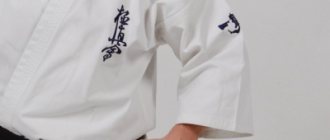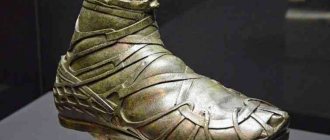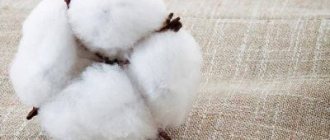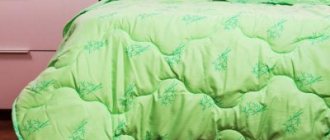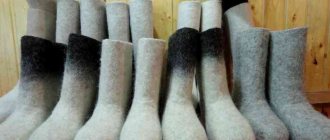Improper washing often leads to deformation of the product, shrinkage or change in the shade of the material. A sports kimono is made from natural dense fabric, which does not always retain its perfectly snow-white color and shape after cleaning. It is necessary to consider not only what, but also how to wash a kimono so that it retains its appearance for a long time.
It is best not to wash a kimono in a washing machine, but to use special professional products.
There is a SmellOff remedy for sweat odor that will relieve you of this ailment without damaging the fabric or color of the product.
To eliminate the smell of sweat, you need to:
- Clean the kimono from visible dirt and dry thoroughly.
- Apply the neutralizer by spraying onto the entire product, paying special attention to places where sweat is most often produced by a person, for example, the armpits. It would be most appropriate and effective to pour the product into these places. Thus, it will reach the greatest depth of the product.
- After treatment, it is necessary to allow the product to dry completely for 12-24 hours and then ventilate.
With the help of numerous studies, it has been proven that after proper processing, the product does not even smell like fragrance.
Important rules on how to wash kimonos for judo, karate and other martial arts
A special type of sportswear, without which it is impossible to imagine martial arts training, is a kimono.
This lightweight clothing, made only from natural fabrics, does not restrict movement, is comfortable to wear and resistant to wear.
The secrets of proper washing will help you preserve the original appearance of your clothes longer. We will tell you in the article how to wash a kimono (for judo, karate) in a washing machine and by hand.
Material
Karate kimonos are made from different materials, both natural and synthetic. They all have different properties, and the selection of suitable material depends, first of all, on the type of combat.
- Kata. This karate technique includes attacking and defensive movements that are carried out with one or more invisible opponents, shadow boxing. Demonstration fights are held in kata. The best kimono you can choose for kata is made from high-density natural cotton. It will perfectly remove moisture during combat and allow air to pass through. Thick cotton with a tight weave will make a loud bang. And in kata competitions this is an important indicator. The stronger the acoustic effect, the better.
- Kumite. This type of combat, unlike kata, is fought against an opponent and requires high intensity of movements. Several fights may take place during the competition. In order for a fighter to feel comfortable during fights, the kimono must breathe well, remove moisture, and be light. Therefore, kimonos made of mixed fabric and polyester, an ultra breathable and incredibly light material, are suitable for kumite. The better these properties of the fabric, the better the athlete feels.
- Traditional karate. If you need a kimono for traditional karate, then you can consider models made of 100% cotton and models made of mixed fabrics. If you have been practicing traditional karate for several days, the classic heavy cotton kimono will suit you. It is made from fairly dense fabric, so it will serve you for a long time. At the same time, the kimono will be comfortable to wear and comfortable in battle. For beginners, it is best to consider a kimono made from mixed fabrics so that it is fairly lightweight, easy to care for and inexpensive. In such a uniform, daily training will be comfortable and productive.
Kimonos not only made from cotton, but also from mixed fabrics are also suitable for children. Modern kimono fabrics are lightweight and do not cause discomfort. Active young athletes will not feel hot in them. These uniforms are high quality and low priced, so you won't have to worry about your child growing out of them too quickly. In addition, mixed fabric is easier to care for: it shrinks less when washed, dries faster, and irons better.
Washing secrets
You can wash a kimono either by hand or using a washing machine.
The only thing that, regardless of the choice of washing method, is necessary:
- strictly adhere to the temperature regime (no more than 40C),
- never wash white and colored kimonos together,
- Wring out sportswear as carefully as possible.
Ignoring these simple tips may cause final damage to the product.
In the washing machine
To maintain the shape and density of sportswear, it is necessary to adhere to a clear sequence of machine washing steps:
- Before loading clothes into the washing drum, get rid of stubborn dirt.
- The required temperature is set: for natural fabrics - no more than 35-40C; for sportswear made from mixed fabrics, a temperature of 40-50C is allowed.
- Powder is poured into a special compartment. For white kimonos, use liquid detergent in combination with oxygen bleach. Special powders for colored fabrics are ideal for colored sportswear.
- Set the required washing mode: delicate or synthetic.
- Spin - no more than 500 revolutions (if the kimono is made from mixed fabrics). For natural materials, machine spinning is prohibited (the function is disabled).
- The prepared clothes are carefully folded and loaded into the washing drum (the colored belt is washed separately).
- After washing, sportswear should be immediately taken out and hung to dry.
Hands
Delicate, gentle hand washing will help quickly return the kimono to purity and freshness without compromising the shape and color of the product.
Algorithm of actions:
- a basin or bathtub is filled with warm water (temperature no higher than 40C), liquid detergent or powder is added;
- a dirty kimono is turned inside out and immersed in a soapy solution for several hours;
- then wash the product with gentle, squeezing movements, paying special attention to the fabric on the collar, cuffs and armpits;
- the washed product is thoroughly rinsed two or three times until the soap solution is completely removed from the fabric;
- The kimono is carefully wrung out and hung out to dry.
Do I need to soak?
If sportswear is very dirty, it should be soaked before the main wash.
White sportswear is soaked for half an hour in a soda solution (2 tablespoons of soda are dissolved in 10 liters of water).
How to clean a belt?
An integral part of a martial arts fighter's costume is a belt. Depending on the level of skill, a belt of a certain color is selected.
You should not ignore belt care, as a dirty element of the costume against the backdrop of a snow-white kimono spoils the overall impression of the fighter’s appearance.
The easiest way to wash a white belt is. It is placed in a special net (or pillowcase) and loaded into the drum of the washing machine along with the kimono.
Colored belts are washed according to the following scheme:
- Warm water (no more than 40C) is poured into a basin and powder or liquid detergent for colored fabrics is added.
- The belt is immersed in a soapy solution and left to soak for ten to fifteen minutes.
- Afterwards, the belt is thoroughly wrinkled, and if necessary, especially contaminated areas are treated with a brush and laundry soap.
- The washed belt is rinsed in clean running water and hung out to dry.
Bleaching the kimono and belt at the same time. This will help avoid a situation where individual parts of one martial arts suit differ in shade.
Belt care
The belt is the most important element of a judoka's costume. In some traditional martial arts schools, it is not customary to wash the belt, but if against the background of snow-white clothes the belt looks grey-yellow, it will look untidy. Still, it is better to keep all parts of the form clean.
For a dark-colored belt, it is enough to use powder for colored laundry. The white belt must be washed by hand. It is necessary to bleach all the details of the costume at the same time, so that there is no “discord” in shades.
How to remove various stains?
The recipe for getting rid of it depends on the type of stain itself.
- A vodka solution will help remove sweat stains from colored fabrics (vodka and water are mixed in a 1:1 ratio). It is enough to soak the dirty item in the prepared solution and leave for half an hour. Afterwards the product is washed in the usual way.
- Hydrogen peroxide will help remove blood stains from a white kimono. It is enough to moisten the stain generously with peroxide, wait until the reaction occurs, and remove the stain with a cotton sponge.
- Laundry soap will help get rid of grass stains. Rub the dirt with soap and leave it alone for ten to fifteen minutes. Afterwards the clothes are washed in the main mode.
- Hydrogen peroxide and ammonia (mix in equal proportions) will help get rid of yellow spots. The resulting solution is diluted in water (3-4 spoons per 10 liters), in which the kimono is soaked. After an hour, the clothes are washed as usual.
- If a rust stain appears on a white item after washing, lemon will help remove it. You need to wrap a piece of lemon in gauze and a paper napkin, apply it to the stain and press with a hot iron.
How to return the color?
You can return the original whiteness and freshness in the following ways:
- Lather the fabric with laundry soap and leave the clothes alone for two hours. The product can then be washed as usual.
- Deciduous wood ash is an excellent folk remedy for bleaching natural cotton and linen.
The ash is poured into a gauze bag and placed in the drum of the washing machine along with dirty clothes.
- A saline solution will help quickly restore the whiteness of a cotton kimono. In 10 liters of oxen, dissolve 2 tablespoons of salt, and place the product in the resulting solution for half an hour. Afterwards, the clothes are washed in the usual way.
- A solution of hydrogen peroxide (2 tbsp), ammonia (1 tbsp) and water (10 l) helps to cope not only with the gray tint of a washed item, but also with old stains. The kimono is immersed in the prepared solution, left for forty minutes, after which it is washed by hand or in a machine.
Whitening without chemicals
Ash is a universal product that washes dishes and hair, is used as fertilizer for the garden, and is also suitable for washing and bleaching clothes. Use ash only of plant origin, preferably deciduous trees, such as birch or aspen.
To wash white clothes, take the ash and place it in gauze, tie it tightly and place it in a container with water and dirty clothes. Place on the stove and boil. Let the solution cool, then wash and rinse the items in clean water. Universal ash is suitable for bleaching natural cotton, linen and synthetics.
In addition, you can use a solution of potassium permanganate and a soap solution made from shavings of laundry or antibacterial soap. We combine both mixtures and put two or three white things there that need to be bleached. Leave it overnight and then rinse. As a result, you will get snow-white fabric without stains or dirt.
Chemical bleaching compounds will replace ammonia and hydrogen peroxide. For 10 liters of water add 2 tablespoons of peroxide and 1 tablespoon of ammonia. Mix and soak the items in the prepared solution. Leave for several hours and rinse. As a result, things will return freshness and whiteness. How else to return the whiteness to grayed things, read the link.
How to remove the smell?
A kimono soaked in sweat begins to smell unpleasant. One proven method will help remove the smell of sweat: just soak the clothes in water with vinegar (2 tablespoons of vinegar per 10 liters of water). After soaking, the clothes are thoroughly rinsed and hung out to dry.
The following recommendations will help minimize the appearance of unpleasant odors:
How to dry?
It is strictly forbidden to dry a kimono made from natural fabrics in an automatic machine, twist it too much, or stretch it. From such actions, the fabric stretches and loses its shape and original appearance.
Basic drying rules:
- Immediately after machine washing, clothes must be removed from the drum and hung out to dry. Delay can lead to the formation of creases and folds on the fabric, which will be very difficult to get rid of.
Also, leaving a damp kimono in the washing machine for a long time can cause a very unpleasant, musty odor to appear, which can only be removed by repeated washing.
Sportswear made from natural fabrics takes a long time to dry, so you should be patient and have a second set of replacement uniforms for training.
Adviсe
Recommendations for caring for the product are as follows:
- It is strictly forbidden to wash kimonos in hot water. When exposed to high temperatures, the product may shrink in size.
- Adding conditioner to the water during rinsing will help make the fabric soft and pleasant to the touch.
- Do not soak a kimono in hot water. Under the influence of high temperatures, dirt is further absorbed into the fibers of the fabric, and sportswear takes on a gray tint and a washed-out appearance.
- Regardless of the composition of the fabric, automatic drying for kimonos is not acceptable.
You will find maximum useful information about washing clothes and various fabric products here.
Methods for removing stains and eliminating unpleasant odors
Athletes who initially purchase expensive kimono options enjoy the whiteness of their equipment for a long time. Cheaper models acquire a grayish or yellowish tint after some time, even if they are cared for according to all the rules. It’s just that in the first case the fabric is initially bleached, and in the second you have to do it yourself. If you find stubborn stains that cannot even be bleached, you must contact a dry cleaner.
The process of bleaching cotton involves the use of special substances that increase the alkalinity of the washing composition. This leads to the destruction of fats, which are the cause of specific contaminants that give the fabric an unnecessary shade. Cellulose, which is the basis of cotton, is not very susceptible to such effects, so properly carried out bleaching will not negatively affect the condition of the material. Here you just need to choose products that do not contain chlorine. This element can weaken fabric fibers.
In addition to stains, kimonos often become a source of unpleasant odors. This will not happen if you remember the following points:
- After training, the kimono must be dried as quickly as possible; it must not be left in the bag.
- If possible, after each lesson, it is recommended to rinse the product in cold water and dry it in the fresh air.
- If the smell does appear, then before rinsing you need to add about two tablespoons of vinegar to cold water.
- When washing things in a machine, you need to use powders with fragrances, softeners and conditioners with fragrances.
- During the winter months, kimonos can be regularly hung out in the cold.
If the product does not shrink when washed in hot water, then it is better to process it at a temperature of about 65ºC. This will destroy most of the bacteria that cause the unpleasant odor.
How to wash a kimono
Improper washing often leads to deformation of the product, shrinkage or change in the shade of the material. A sports kimono is made from natural dense fabric, which does not always retain its perfectly snow-white color and shape after cleaning. It is necessary to consider not only what, but also how to wash a kimono so that it retains its appearance for a long time.
It is best not to wash a kimono in a washing machine, but to use special professional products.
There is a SmellOff remedy for sweat odor that will relieve you of this ailment without damaging the fabric or color of the product.
To eliminate the smell of sweat, you need to:
- Clean the kimono from visible dirt and dry thoroughly.
- Apply the neutralizer by spraying onto the entire product, paying special attention to places where sweat is most often produced by a person, for example, the armpits. It would be most appropriate and effective to pour the product into these places. Thus, it will reach the greatest depth of the product.
- After treatment, it is necessary to allow the product to dry completely for 12-24 hours and then ventilate.
With the help of numerous studies, it has been proven that after proper processing, the product does not even smell like fragrance.
What you need to know about washing kimonos in the washing machine
Water temperature, products, frequency of cleaning the product and much more are taken into account. All this is necessary to know to carefully care for the item. Kimonos are usually made from 100% cotton. Despite the fact that this fabric is durable and resistant to various impacts, it shrinks about 3-5% (and when using hot water up to 10%).
Important! Cotton stains easily, so it should not be washed together with clothes of other colors. The belt is cleaned with a detergent for colored items, and soap or chlorine-free products are used to remove stains.
Temperature
It is recommended to wash pure cotton at temperatures up to 30 degrees.
If the judo kimono is made of cotton fabric with the addition of synthetic fibers, then the temperature can be increased to 80 degrees. Many people resort to increasing the temperature, believing that in this way they can treat the product against bacteria. In fact, cotton can withstand up to 90 degrees, but clothes shrink and become deformed. It is impossible to say exactly how much a kimono shrinks after washing, but it is recommended to buy a product one size larger. If it is too large, you can try washing it at a high temperature.
It is worth paying attention to the fact that the material does not always shrink equally in all directions - it all depends on the fabric and the direction of the threads. For example, clothes for judo and karate often fit widthwise rather than lengthwise. This can be corrected by hemming the length of the product and sleeves after washing.
Washing frequency
Sportswear must be washed after each activity, but it is not necessary to use a washing machine for this. The frequency of cleansing depends on the intensity, duration and schedule of training, as well as the characteristics of the body. Many people simply rinse the mold in cool water by hand and dry it on a horizontal surface. How often you will have to wash your karate kimono is up to you to decide, based on the degree of contamination of the product.
Sometimes during classes it is permissible to wear a thin T-shirt or other underwear - this will allow some of the sweat to be absorbed and prevent the kimono from turning yellow. Before training, it is advisable to thoroughly wipe the floor so as not to stain your sportswear.
Selection of powders and other substances
Products are available for machine and hand washing, for colored and white items. Kimonos are washed only with white laundry powder or with bleaching particles. It is better to use gels that are easy to wash off and do not leave marks on the fabric. Often the remaining powder in the product causes a severe allergic reaction.
Before bleaching your white kimono in the washing machine, you can hand wash the collar, cuffs and armpit areas. These areas most often turn yellow from contact with the skin, and machine washing does not always remove stains.
Popular cotton fabrics
Batiste: lightness and airiness. How to preserve the beauty and brightness of fabric color?
Taffeta is a fabric for festive events and home interiors. Capricious luxury and spectacular drapery
Is calico a fabric just for bed linen or is it good for something else?
Pima Cotton: The softest type of cotton fabric. One of the most comfortable and delicate materials for the production of expensive luxury products
Poplin is a popular material for bedding and more
Satin lux: natural breathable cotton fabric with the characteristics of silk. One of the best materials for sewing expensive linen
Marquisette is an airy fabric originally from France. Will appeal to lovers of natural materials
Whitening kimonos at home
Sometimes a black or colored kimono is chosen for daily training, while white is reserved for demonstration performances. However, this practice is rare, so you need to know how to bleach a kimono yourself without damaging the fabric. A few rules for proper cleaning of products:
- do not use products with chlorine, which destroys the structure of the material;
- pre-soak sportswear in warm soapy water or boil;
- manually wash particularly dirty areas using special bleach;
- rinse after washing in the machine with cold water with the addition of 2-3 tablespoons of vinegar or conditioner to get rid of the unpleasant odor;
- Do not brush old or stubborn stains, otherwise the fabric will wear out;
- Before washing, turn the product inside out.
Constant boiling of the mold leads to severe shrinkage and deformation, so it is better to resort to bleaching. You can boil a kimono that has completely changed its shade to gray or yellow. To do this, place white items in a large saucepan or bucket, add water or soap solution (10 liters per 1 kg of clothing), place on medium heat and bring to a boil. You should stir things from time to time, and after boiling, rinse with clean water. The easiest way to remove stains is to rub small stains with laundry soap and leave for 5-10 minutes, then wash as usual.
Laundry soap
Boiling has always been considered very effective in combating yellowness and grayness of light-colored fabrics. This bleaching method can also be applied to woolen products:
- Grind the laundry soap on a grater to make fine shavings.
- Pour it into a metal container with cold water and stir.
- Put the solution on the fire, and when it becomes warm, put a jacket or hat in the basin. Bring the mixture with clothes to a boil and remove from heat after 10 minutes.
- Drain the boiling water and add warm water. Rinse things thoroughly and drain the mixture.
- Refill with warm water at a temperature of 30-40 degrees and add 5-6 tbsp to it. vinegar for 3-4 liters. Stir.
- Dip white yarn into the mixture, rinse and leave for 5 minutes.
- Drain the water and wring out the product.
After such bleaching, woolen items do not need to be washed with special cleaning agents.
Rules for drying and ironing
To prevent the form from stretching, it must be dried and ironed properly. It is unacceptable to wring out and dry a kimono in a machine, otherwise deformation cannot be avoided. It is better to squeeze the product with your hands gently without twisting too much. It is recommended to dry it in the open air - on a balcony or street; you cannot hang it on a radiator. Some people prefer to take their clothes out into the cold to remove odors. If you follow simple rules, you will be able to avoid damage to the fabric.
The fact is that ironing cotton is extremely difficult even at high temperatures. Products with a woven structure should not be ironed, they just need to be washed and dried properly to prevent wrinkles.
Note! Many people starch kimonos to give the fabric shape and elasticity, but it must be done correctly. In cases where a large amount of starch and a thick solution is used, the product becomes too hard. Washing starch out of fabric will be problematic.
Washing and bleaching a kimono at home is quite simple. To do this, use mild chlorine-free bleaches, powders or liquid products for white laundry. You need to dry the uniform in the fresh air to avoid bad odors. Ironing is usually not required if all steps have been completed correctly.
Source of the article: https://tvjam.ru/stirka/kak-stirat-kimono/
How to wash a kimono: what to do with it after training, how to bleach it, How to wash a kimono until it is white.
What funds are needed?
You can wash sneakers using different means, and their choice depends on the material from which the shoes are made. There are several options:
- For textile sneakers, a high-quality washing powder is suitable. But it must be completely dissolved in water, otherwise small solid particles will get stuck in the fibers of the fabric and damage it. To avoid this, replace the powder with a gel or liquid product.
- For washing, regular solid or liquid soap is suitable, which copes well with minor stains. And laundry soap will help remove even stubborn stains.
- You can effectively clean white or heavily soiled sneakers using a stain remover, but without chlorine or other aggressive components. Use Antipyatin or Vanish.
- Leather sneakers are not subject to regular washing, and dirt does not eat into such material, so to remove them you can use a soap solution, applying it to the surface with a sponge.
- Suede sneakers should also not be washed, as the material can deteriorate when exposed to water. If the shoes are very dirty, then prepare foam from water and soap or washing powder, apply it to a sponge and carefully treat the surface of the products to prevent it from getting too wet. You can also use specialized products for shoes made from these materials to clean suede and nubuck.
Routine care. Refresh and remove odor
After an intense workout, sportswear often becomes damp with sweat. Therefore, you need to take care of your kimono after each use. What should I do?
- Be sure to take the item out of the bag when you arrive home and dry it (preferably in the open air).
- If your clothes are very sweaty, soak them in clean, cool water for a quarter of an hour, then rinse and dry.
- Does your kimono smell bad? Dilute 1 tsp in 10 liters of water. 9% vinegar and, after soaking for a short time, rinse the tracksuit in the solution. The vinegar will kill the bacteria that causes the bad odor. In addition, this procedure will help refresh the color of both white and painted products.
Hand and machine wash
When the kimono gets dirty, it needs to be washed. How often to do this depends on the number of classes per week. For daily training, sportswear is fully washed once a week. For periodic use - twice a month.
Kimonos for current activities are traditionally sewn from pure cotton of varying degrees of density. The fabric of a costume for exhibition performances usually contains polyester. Kimonos also differ in color. Clothing for martial arts can be white or colored (black or blue).
Any type of washing is suitable for kimonos. If the product is heavily soiled, pre-soak it in warm water.
Do not use hot water for pre-soaking. The dirt will become even more embedded in the fibers, and the white suit will take on a grayish tint.
- It is enough to immerse sportswear made of colored fabric in water at room temperature for an average of 2 hours. If the fabric sheds heavily, the treatment time is reduced to half an hour.
- The white form is left for 30 minutes in a soda solution (1-2 tablespoons of substance per 10 liters of water) or in soapy water (1/4 of a grated bar per 10 liters).
Subsequent hand washing is carried out as follows:
- The basin is filled with fresh warm water and shavings of laundry soap or washing powder are dissolved in it. It is better not to use laundry soap for colored items, as it eats up the dye.
- The product turned inside out is immersed in a washing solution and washed by squeezing and unclenching your hands. You cannot rub a kimono (especially one made of pure cotton) too much, otherwise pellets will form.
- Clean items are lightly squeezed from top to bottom to remove excess moisture and rinsed.
When machine washing, the following rules must be observed:
- Kimonos made of white and colored cotton without additives should be washed at 30°. Hotter water is used if the product needs to shrink. Although white cotton will not deteriorate even at 90°, clothes will shrink significantly (after the first wash - an average of 10 cm). A suit made of mixed fabric tolerates temperatures well from 40 to 60°.
- Before putting things into the drum, things are turned inside out and folded. If the belt is a different color from the suit, it should be washed separately.
- The detergent is chosen depending on the color of the fabric. When washing a white kimono, you can add oxygen bleach to the machine's dishwasher, or, if it is not available, a mixture of soda and salt.
- It is safer to wash a kimono in the delicate or synthetic mode. This will prevent possible deformation of the suit.
- If the sports uniform is made of mixed fabric, it can be pressed at 500 rpm. When washing a kimono made of pure cotton, it is better to turn off the spin cycle. Automatic drying cannot be used in any case.
Remove sweat stains and whiten
If the uniform has acquired a grayish tint or sweat stains have appeared on it, chemical and folk remedies will help.
Oxygen bleach is universal. It acts at low temperatures and can be used both during soaking and during washing.
It is strictly not recommended to use substances containing chlorine in the case of kimonos. The fabric will quickly become thinner and the yellow sweat stains will turn gray.
Traces of sweat from the white uniform are removed with warm water diluted with salt 1:1 or an aqueous solution of 9% vinegar. Whitish stains from a colored suit are removed with vodka diluted half and half with water. The mixtures are kept on the contamination for half an hour.
A kimono that has lost its whiteness can be kept for half an hour in one of the following compositions:
- 2 tbsp. l. salt per 10 liters of water;
- 1 tbsp. l. ammonia and 2 tbsp. l. 3% peroxide per 10 liters of water.
This may be useful: Can boxing gloves be washed and how to clean them to get rid of the smell inside.
Using store-bought bleaches
In advanced cases, folk remedies may not cope with the task of bleaching textiles; in addition, the required composition may not be at hand.
Therefore, it is important to keep at least one of the industrial stain-fighting products in the house. Popular and effective store-bought laundry solutions:
- special soap for removing local contaminants. It is used by analogy with the household one, but has a more pronounced effect and often helps the first time;
- oxygen products – an innovation inspired by hydrogen peroxide. Applicable to almost all fabrics, even the most delicate ones, and can be used for items with complex prints;
- Chlorine bleaches are only suitable for materials made from natural plant fibers.
In conclusion, it is worth exploring several ready-made solutions that are popular on the market:
- "Antipyatin" - stain-removing soap;
- “Vanish oxy action” – oxygen powder for textiles, carpets and upholstered furniture;
- “BOS” – compositions for soaking linen in the mid-price category with a preventive effect;
- “Minutka” – a budget line of stain remover pastes;
- "Amway" - organic products with absolute safety and effectiveness, presented on the market at the highest price.
Dry and iron properly
Kimonos are usually not ironed. After washing, carefully remove the water from it and hang it on hangers in the room or outdoors. If, after drying, a wrinkle is found on the form, it is moistened, the fabric is straightened and waited for drying. Sportswear should not be dried:
- on the radiator, as it will shrink from high temperature and may become covered with yellow spots;
- under direct sunlight (colored clothing will fade and white clothing will turn yellow).
As you can see, with regular care, compliance with temperature conditions and a reasonable choice of cleaning products, a kimono can be kept in excellent condition for a long time.
Source of the article: https://hozotsek.ru/tekstil/stirka/kimono.html
